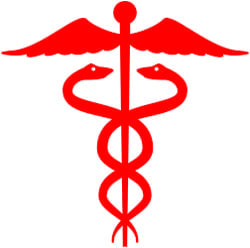Brain Aneurysm
An aneurysm is a weak spot in one of your brain's arteries ( Blood vessels that carry oxygen from your heart to the rest of your body). They tend to happen when arteries fork. Over time, flowing blood puts pressure on a spot and make it give way and balloons out. It's a lot like a worn-out garden hose that bulges where it's gotten thin. Most people who have an aneurysm don't know it. But if it bursts, it can be life threatening and cause brain damage.
There are two types of brain aneurysms based on their shape. Saccular aneurysm also called, berry aneurysm, are by far the most common. A small pouch forms alongside the artery wall, so it looks like a berry with a short stem. Fusiform aneurysms make the artery bulge out in one area. They tend to be more common with people who have hardened arteries( when cholesterol or other fatty substances build up in your arteries and make them narrow).
Mycotic aneurysms are caused by bacterial, fungal, or viral infection that affects arteries in the brain. The infection can cause the artery wall to weaken. This type of aneurysm is rare.
Mycotic aneurysms are caused by bacterial, fungal, or viral infection that affects arteries in the brain. The infection can cause the artery wall to weaken. This type of aneurysm is rare.
Symptoms of Unruptured Aneurysms
This one hasn't burst. Small one typically don't cause symptoms, but larger one can press on your brains and lead to:
* Balance problems
* Headaches
* Numbness or weakness on one side of your face
* Pain above and behind your eye
* Problems seeing, like double vision or loss of sight.
* Trouble talking
*Widened pupils
This one hasn't burst. Small one typically don't cause symptoms, but larger one can press on your brains and lead to:
* Balance problems
* Headaches
* Numbness or weakness on one side of your face
* Pain above and behind your eye
* Problems seeing, like double vision or loss of sight.
* Trouble talking
*Widened pupils
Symptoms of Ruptured Aneurysm
When an aneurysm bursts you'll suddenly have a terrible headache. Some people say it's like a thunderclap. The worst pain they have ever known. You also may have:
* Blurred or double vision
* Confusion
* Loss of consciousness
* Seizures
* Sensitivity to light
* Stiffness or pain in your neck
* Upset stomach and throwing up
* Weakness along one side of your body
When an aneurysm bursts you'll suddenly have a terrible headache. Some people say it's like a thunderclap. The worst pain they have ever known. You also may have:
* Blurred or double vision
* Confusion
* Loss of consciousness
* Seizures
* Sensitivity to light
* Stiffness or pain in your neck
* Upset stomach and throwing up
* Weakness along one side of your body
A burst aneurysm causes bleeding in your brain that leads to what's called a hemorrhagic a stroke. ( A stroke is when part of your brain doesn't get the blood it needs). The blood itself, and the swelling and pressure that come along with it, can cause brain damage. Fluid from your brain and spine also may back up and add more pressure. Once this happens, there's a chance the aneurysm may bleed again, and the arteries in your brain can get narrow, which can cause another stroke.
Doctors aren't exactly sure what causes an aneurysm. But your age and gender might affect your chances. Most people who have them are over 40, and women have them more often than men. This might be because levels of hormones called estrogen, drop after menopause and may make a woman's blood vessel more rigid. Your family history may also play a role. You're more likely to have one idf a parent, brother, or sister had one.
Some health problems may make it more likely to have an aneurysm, including certain conditions you were born with, like polycystic kidney disease, or tissue disorders like, Ehlers-Danlos syndrome. Your chances are also higher, if you have hardened arteries, high blood pressure or a serious head injury. Some lifestyle choices can raise your risk, too, like heavy drinking, smoking, or using illegal drugs, especially cocaine.
Credit: WebMD
Credit: WebMD







